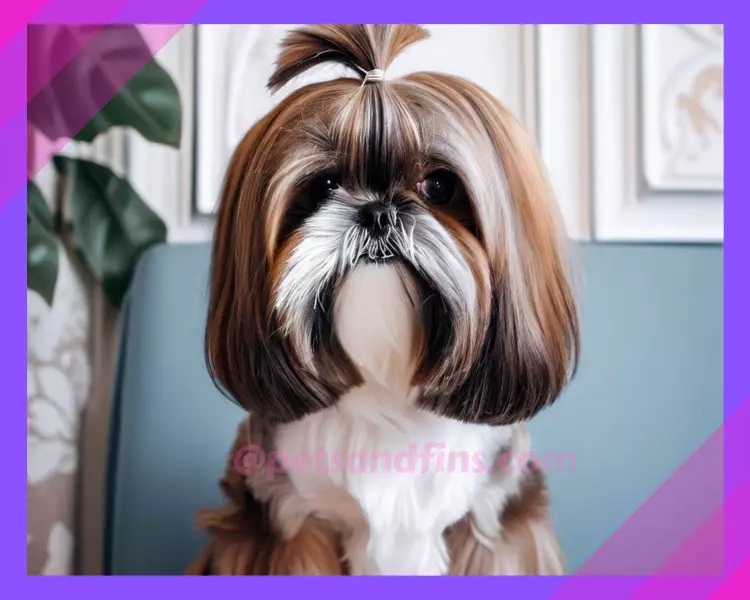This article will deal with ‘Dog Shedding During Bath Time. 14 Amazing Tips‘. Dealing with dog shedding during bath time can be a common challenge for pet owners. The sight of loose hair all over your bathroom floor and clogging up the drain can be frustrating.
However, with the right strategies and techniques, you can effectively manage and minimize shedding during bath time. In this article, we will explore 14 helpful tips that can make bath time a more pleasant experience for both you and your furry companion. From grooming techniques and proper bathing practices to nutrition and preventive measures, these tips will help you tackle the issue of shedding head-on.
By implementing these strategies, you can keep your dog’s coat healthy, reduce shedding, and create a cleaner and more enjoyable bathing routine. Let’s dive in and discover how to make bath time a shed-free experience for your beloved canine companion.
My Personal Experience With My Dogs

My Shih Tzu, Miko, has been my constant companion for the past five years. She is a small dog with long, silky hair that requires regular grooming. However, I noticed that she was shedding a lot of hair recently. At first, I thought it was just her natural shedding cycle. But when it didn’t stop after a few weeks, I became concerned.
I took Miko to the vet to see if there was an underlying health issue causing her excessive shedding. The vet examined her and found that she was perfectly healthy but had dry skin due to lack of proper nutrition.
The vet suggested adding vitamin supplements to Miko’s diet to improve her skin and coat health. I immediately started giving her daily doses of vitamins A and E along with omega-3 fatty acids.
Within a few days, I noticed a significant improvement in Miko’s coat quality. Her hair stopped falling out in clumps and became softer and shinier than ever before. Not only did the supplements help with her shedding problem, but they also improved her overall health. So presenting Dog Shedding During Bath Time. 14 Amazing Tips.
Dog Shedding During Bath Time. 14 Amazing Tips

1.Give The Dog A Haircut
Giving your dog a haircut can be an effective way to manage excessive shedding during bath time. Regular grooming and trimming of your dog’s coat can help reduce the amount of loose hair that ends up in the bathwater and throughout your home.
Depending on your dog’s breed and coat type, you can opt for a complete haircut or simply trim the longer hair to a more manageable length.
However, it’s important to use proper grooming tools and techniques, or seek the assistance of a professional groomer, to ensure a safe and comfortable experience for your furry friend.
Regular haircuts not only help control shedding but also contribute to your dog’s overall hygiene and appearance, making bath time a more pleasant experience for both of you.
2.Brushing Regularly
One of the most essential tips for dealing with dog shedding during bath time is to brush your dog regularly. Regular brushing helps remove loose hair from your dog’s coat before it has a chance to end up in the bathwater.
This not only reduces shedding during the bathing process but also helps prevent excessive shedding between baths. Choose a brush that is suitable for your dog’s coat type, whether it’s a slicker brush, a shedding blade, or a grooming rake.
Establish a brushing routine and make it a positive and enjoyable experience for your dog. Not only does brushing control shedding, but it also promotes a healthy coat, stimulates blood circulation, and strengthens the bond between you and your furry companion.
Remember to be gentle and patient while brushing, focusing on all areas of the body, including the undercoat, to effectively manage shedding during bath time.
3.Choose The Right Brush
Choosing the right brush for your dog is crucial when it comes to managing shedding during bath time. Different breeds and coat types require different types of brushes.
For dogs with short, smooth coats, a bristle brush or a rubber curry brush works well to remove loose hair and stimulate the skin. Dogs with long, flowing coats may benefit from a slicker brush or a pin brush to prevent matting and tangles.
If your dog has a double coat, like many breeds, a combination of a slicker brush and an undercoat rake will help remove loose hair from the dense undercoat.
It’s important to do some research or consult a professional groomer to determine the appropriate brush for your specific dog’s coat.
Using the right brush not only helps control shedding during bath time but also promotes a healthy coat and keeps your furry friend looking their best.
4.Use A Shedding Tool
Using a shedding tool can be a game-changer when it comes to dealing with dog shedding during bath time. These specialized tools, such as deshedding brushes or grooming gloves, are designed to remove loose hair from your dog’s coat effectively.
The shedding tool typically features specially designed teeth or bristles that reach deep into the coat to remove loose hair from the undercoat without causing any discomfort to your furry friend.
When using a shedding tool, be sure to follow the instructions provided by the manufacturer and use gentle, sweeping motions to remove the loose hair.
Using a shedding tool not only helps minimize shedding during bath time but also reduces the amount of hair left behind in your home.
It’s important to note that not all shedding tools are suitable for every dog, so it’s recommended to choose a tool that matches your dog’s coat type and seek guidance from a professional groomer if needed.
5.Increase Water Intake
Increasing your dog’s water intake can play a significant role in managing shedding during bath time. Proper hydration helps maintain healthy skin and coat, reducing excessive shedding.
Ensure that your dog always has access to fresh, clean water throughout the day. You can encourage water intake by placing multiple water bowls in different areas of your home, especially near your dog’s favorite spots.
If your dog doesn’t drink enough water naturally, you can try adding wet food or a small amount of low-sodium chicken broth to their meals to entice them to drink more.
Additionally, consider investing in a pet fountain, as some dogs prefer running water and may be more inclined to drink from it.
Adequate hydration not only promotes overall health but can also contribute to a healthier coat, resulting in reduced shedding during bath time.
6.Bathing Often
Bathing your dog often can be a helpful strategy for managing shedding during bath time. Regular baths help remove loose and dead hair from your dog’s coat, preventing it from shedding excessively.
The frequency of baths will depend on your dog’s breed, coat type, and lifestyle. Some dogs may require more frequent baths, especially those with longer or thicker coats, while others may only need occasional baths.
It’s important to use a gentle, dog-specific shampoo that won’t dry out their skin or strip their coat of its natural oils. Remember to rinse your dog thoroughly to remove all the shampoo residue, as leftover residue can cause itchiness and dryness.
After the bath, gently towel-dry your dog and use a blow dryer on a low setting to avoid stressing their skin.
Regular baths, done appropriately, not only help manage shedding but also keep your dog clean and fresh, enhancing their overall well-being.
7.Conditioner
Using a conditioner during bath time can be a valuable tool in dealing with dog shedding. A good quality conditioner can help moisturize and nourish your dog’s coat, reducing shedding by keeping the hair healthy and less prone to breakage.
Look for a conditioner specifically formulated for dogs, as human products may contain ingredients that can be harmful to their skin.
After shampooing your dog, apply the conditioner and gently massage it into their coat, focusing on the areas where shedding is more prominent.
Let the conditioner sit for a few minutes to allow it to work its magic before thoroughly rinsing it off. Conditioning not only helps reduce shedding during bath time but also leaves the coat softer, smoother, and more manageable. Rince thoroughly.
It’s important to choose a conditioner that suits your dog’s specific needs, and if you’re unsure, consult with a veterinarian or professional groomer for recommendations.
8.Brush After Bath
Brushing your dog after bath time is a crucial step in managing shedding. Once your dog is clean and dry, take the time to thoroughly brush their coat to remove any remaining loose hair that may have loosened during the bathing process.
Use a brush suitable for your dog’s coat type and gently work through the fur, paying extra attention to areas where shedding is more prominent, such as the undercoat or tail.
Brushing after bath time helps to remove any tangles or mats that may have formed and ensures that the coat is free of excess hair. It also gives you an opportunity to inspect your dog’s skin for any abnormalities or signs of irritation.
Regular brushing after bath time not only helps control shedding but also promotes a healthy and shiny coat, making your dog look and feel their best.
9.Supplements
Consulting with your veterinarian and getting vitamin supplements prescribed can be beneficial in managing dog shedding during bath time.
Certain vitamins and minerals, such as omega-3 fatty acids, biotin, and zinc, play a vital role in maintaining a healthy coat and minimizing excessive shedding. Your veterinarian can assess your dog’s specific nutritional needs and recommend appropriate supplements to support their coat health.
These supplements can help nourish the skin, strengthen the hair follicles, and reduce shedding. It’s important to follow your veterinarian’s advice and dosage instructions when administering the supplements to ensure your dog’s safety and well-being.
Remember that vitamin supplements should be used as part of a comprehensive approach to managing shedding, along with a balanced diet, regular grooming, and other recommended strategies.
10.Nutritious Food
Providing your dog with a nutritious diet is essential for managing shedding during bath time.
A well-balanced diet rich in high-quality proteins, healthy fats, vitamins, and minerals promotes a healthy coat and minimizes excessive shedding.
Opt for dog food that is specifically formulated to support skin and coat health, as these often contain essential nutrients like omega-3 fatty acids and biotin. Avoid foods with fillers or artificial additives that may contribute to poor coat condition.
Consult with your veterinarian to determine the best diet for your dog’s specific needs, taking into account factors such as breed, age, and any underlying health conditions.
By providing your dog with nutritious food, you’ll be taking an important step in managing shedding during bath time and promoting overall well-being.
11.See A Vet
Setting up a veterinary appointment to check for allergies or skin infections is a vital step in managing dog shedding during bath time.
Allergies, whether they are food-related, environmental, or caused by certain ingredients in grooming products, can lead to excessive shedding and skin irritation.
Similarly, skin infections, such as fungal or bacterial infections, can also contribute to shedding. A veterinarian can perform a thorough examination of your dog’s skin, conduct allergy tests if necessary, and recommend appropriate treatment options.
They may prescribe medications, recommend dietary changes, or suggest hypoallergenic grooming products to address the underlying causes of shedding.
By addressing any allergies or skin infections, you can effectively manage shedding during bath time and ensure your dog’s comfort and well-being.
12.Is It Seasonal
It’s important to consider whether the shedding is seasonal when dealing with dog shedding during bath time. Many dogs naturally shed their coats in response to changing seasons.
Seasonal shedding typically occurs during spring and fall when dogs transition between their winter and summer coats. During this time, you may notice a significant increase in shedding.
Understanding and recognizing this natural shedding pattern can help alleviate concerns about excessive shedding during bath time. During seasonal shedding periods, regular brushing and grooming become even more important to remove loose hair and prevent it from ending up in the bathwater.
However, if you notice excessive or prolonged shedding that is not consistent with seasonal patterns, it may be worth consulting with your veterinarian to rule out any underlying health issues.
By recognizing the seasonal shedding patterns, you can adjust your grooming routine and better manage shedding during bath time.
13.Check For Fleas And Ticks
Checking for fleas and ticks is an essential step in managing dog shedding during bath time. Fleas and ticks can cause skin irritation and lead to excessive scratching, which in turn can contribute to shedding.
These parasites can also leave behind droppings or cause allergic reactions, further exacerbating shedding issues. Before bathing your dog, carefully inspect their fur, especially in areas where fleas and ticks are commonly found, such as around the neck, ears, and belly.
Look for signs of infestation, such as live insects, flea dirt (small black specks resembling ground pepper), or engorged ticks. If you discover any fleas or ticks, consult with your veterinarian to determine the best course of action for effective treatment and prevention.
By addressing fleas and ticks, you can alleviate skin irritation and reduce shedding, making bath time a more pleasant experience for your dog.
14. Hydration
Keeping your dog hydrated is crucial when it comes to managing shedding during bath time. Proper hydration helps maintain the overall health of your dog’s skin and coat, reducing the likelihood of excessive shedding.
Ensure that your dog always has access to clean, fresh water throughout the day, especially before and after bath time. Encourage your dog to drink water by providing multiple water bowls in easily accessible locations.
If your dog doesn’t drink enough water naturally, consider adding wet food or a small amount of low-sodium chicken broth to their meals to entice them to drink more.
Proper hydration not only promotes a healthy coat but also supports your dog’s overall well-being. By keeping your dog hydrated, you can help manage shedding during bath time and contribute to their overall comfort and health.
Summary
In conclusion, managing dog shedding during bath time requires a multifaceted approach.
By following these 14 tips, you can effectively deal with shedding and make bath time a more enjoyable experience for both you and your furry friend.
From giving your dog a haircut to brushing regularly, choosing the right brush, and using shedding tools, there are various strategies to reduce shedding. Additionally, providing nutritious food, increasing water intake, and using conditioners can promote a healthy coat and minimize excessive shedding.
It’s also important to address potential underlying issues such as allergies, skin infections, or flea infestations. Finally, regular veterinary check-ups, especially to determine if shedding is seasonal, can provide valuable insights and ensure your dog’s overall health.
By incorporating these tips into your grooming routine, you can effectively manage shedding during bath time and keep your dog’s coat healthy, shiny, and beautiful.
How To Stop Dog Shedding Home Remedy

When it comes to home remedies for stopping dog shedding, there are a few methods you can try.
First, ensure that your dog is receiving a balanced and nutritious diet, as a healthy coat starts from within. Adding supplements rich in omega-3 fatty acids or biotin can also promote a healthier coat and reduce shedding.
Regular brushing is essential to remove loose hair, so invest in a high-quality brush suitable for your dog’s coat type and make it a part of your routine.
Another home remedy is using natural ingredients such as coconut oil or apple cider vinegar. Applying a small amount of coconut oil to your dog’s coat can moisturize the skin and reduce shedding.
Diluting apple cider vinegar with water and using it as a final rinse after bathing can help restore the pH balance of the skin and promote a healthy coat.
However, it’s important to note that home remedies may not work for every dog, and it’s always a good idea to consult with a veterinarian for personalized advice and guidance.
No Matter How Much I Brush My Dog He Still Sheds

If you find that no matter how much you brush your dog, they still shed, it can be frustrating.
However, shedding is a natural process for dogs, and some breeds are more prone to shedding than others.
It’s important to remember that regular brushing does help to remove loose hair and minimize shedding, but it may not completely eliminate it.
There are a few factors to consider in such cases. First, ensure that you’re using the right type of brush for your dog’s coat.
Different breeds have different coat types, and using the appropriate brush can make a difference.
Additionally, make sure you’re brushing thoroughly and reaching all areas, including the undercoat.
If shedding seems excessive or abnormal, it may be worth consulting with a veterinarian to rule out any underlying health issues or nutritional deficiencies.
Sometimes, shedding can also be influenced by environmental factors or stress.
Overall, while regular brushing is important, it’s essential to understand that shedding is a natural process and can vary from dog to dog.
De-shedding Bath For Dogs

A de-shedding bath for dogs can be an effective way to manage shedding and keep your furry friend’s coat healthy and tidy.
Start by choosing a high-quality de-shedding shampoo specifically designed to reduce shedding.
These shampoos often contain ingredients like natural oils and moisturizers that help loosen and remove dead hair.
Before bathing, thoroughly brush your dog’s coat to remove any loose hair and tangles. During the bath, massage the de-shedding shampoo into your dog’s coat, focusing on areas prone to shedding, such as the back and sides.
Let the shampoo sit for a few minutes to allow it to work its magic. Rinse your dog thoroughly to ensure all the shampoo and loose hair are washed away.
After the bath, use a de-shedding tool or a grooming brush to further remove any remaining loose hair.
Remember to follow the instructions provided by the de-shedding shampoo and use caution around sensitive areas like the face and ears.
A de-shedding bath, when done correctly, can significantly reduce shedding and leave your dog with a cleaner and healthier coat.
How To Stop Dog Shedding, Short Hair

If you have a dog with short hair that sheds, there are several steps you can take to help minimize shedding.
Regular brushing is essential, even for short-haired dogs, as it helps remove loose hair before it ends up on your furniture or clothes.
Use a grooming brush specifically designed for short-haired breeds to effectively capture and remove loose hair.
Additionally, ensure that your dog is receiving a balanced and nutritious diet to promote a healthy coat.
Regular baths with a gentle shampoo can also help remove loose hair and keep the skin and coat in good condition.
Consider using a deshedding tool or glove during the bath to further remove any remaining loose hair.
Finally, keep your dog hydrated and consult with your veterinarian to rule out any underlying health issues that may be contributing to excessive shedding.
By following these tips, you can effectively manage shedding in your short-haired dog and maintain a clean and tidy home environment.
How To Reduce Dog Shedding In House

Reducing dog shedding in your house requires a combination of preventive measures and regular maintenance.
First, ensure that your dog is on a healthy diet with high-quality food that promotes a healthy coat. Regular brushing is crucial to remove loose hair and prevent it from spreading around the house.
Choose a suitable brush for your dog’s coat type and establish a consistent brushing routine. Regular baths with a shedding-control shampoo can also help minimize shedding.
Keep your home clean by vacuuming regularly, especially in areas where your dog spends the most time.
Consider using furniture covers or blankets to protect your upholstery and bedding from excess hair.
Maintaining a healthy environment by dusting and using air purifiers can help reduce airborne allergens that can contribute to shedding.
Additionally, washing your dog’s bedding and blankets regularly can help control shedding.
By implementing these tips, you can effectively reduce dog shedding in your house and create a cleaner and more comfortable living space for both you and your furry friend.
References:
1. Kogan, L., & Schoenfeld-Tacher, R. (2018). Shedding: A review of the science behind reducing hair loss in companion animals. Veterinary Sciences, 5(4), 96. US Veterinarians’ Knowledge, Experience, and Perception Regarding the Use of Cannabidiol for Canine Medical Conditions – PubMed (nih.gov)
2. Landsberg G., Hunthausen W., & Ackerman L. (2013). Handbook of Behavior Problems of the Dog and Cat (3rd ed.). Elsevier Health Sciences.
3. Whitehead M.L., & Houpt K.A.(1987). Shedding in dogs: causes and effects on allergen exposure. Journal of Small Animal Practice 28(12), 1089
